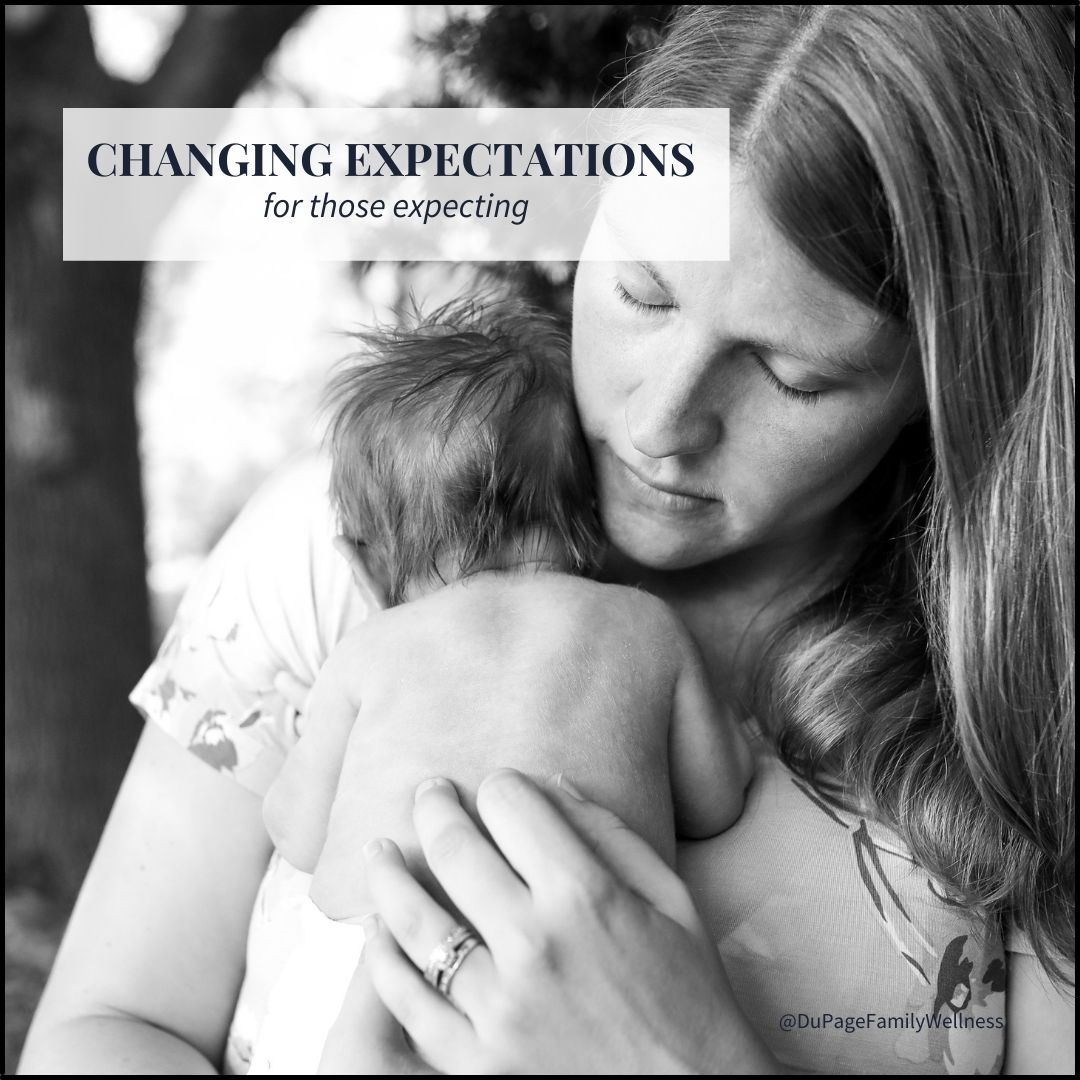 Pregnant moms get all sorts of questions. Is this your first? When are you due? Is it a boy or a girl? These questions are born out of excitement and anticipation, but some of these questions are not as straightforward as you may think.
Pregnant moms get all sorts of questions. Is this your first? When are you due? Is it a boy or a girl? These questions are born out of excitement and anticipation, but some of these questions are not as straightforward as you may think.
Consider the question, “When are you due?” While there may be a prescribed due date, what does that mean? Can we really predict with accuracy when the baby will be born?
There are so many factors that come into play. So, how much weight should we give these dates? And are there better methods of predicting a due date?
Let’s look at the history of how due dates are calculated and consider if our ideas about due dates are really accurate.
History
In the 1700’s, Hermann Boerhaave developed a method to calculate an estimated due date by studying the records of 100 pregnant women. He determined that adding 7 days from the last period and then adding nine months would result in an estimated due date. But Boerhaave never clarified whether this formula should use the first or last day of the woman’s period.
In the 1800’s Carl Naegele expanded Boerhaave’s thoughts, but he did not specify if the formula was based on the first or last date of the mother’s period either
For years doctors used the last day of the last period to calculate due dates. But by the 1900’s it became the standard to calculate it from the first day of the last period. Today this calculation is called “Naegele’s Rule.”
Read more ...
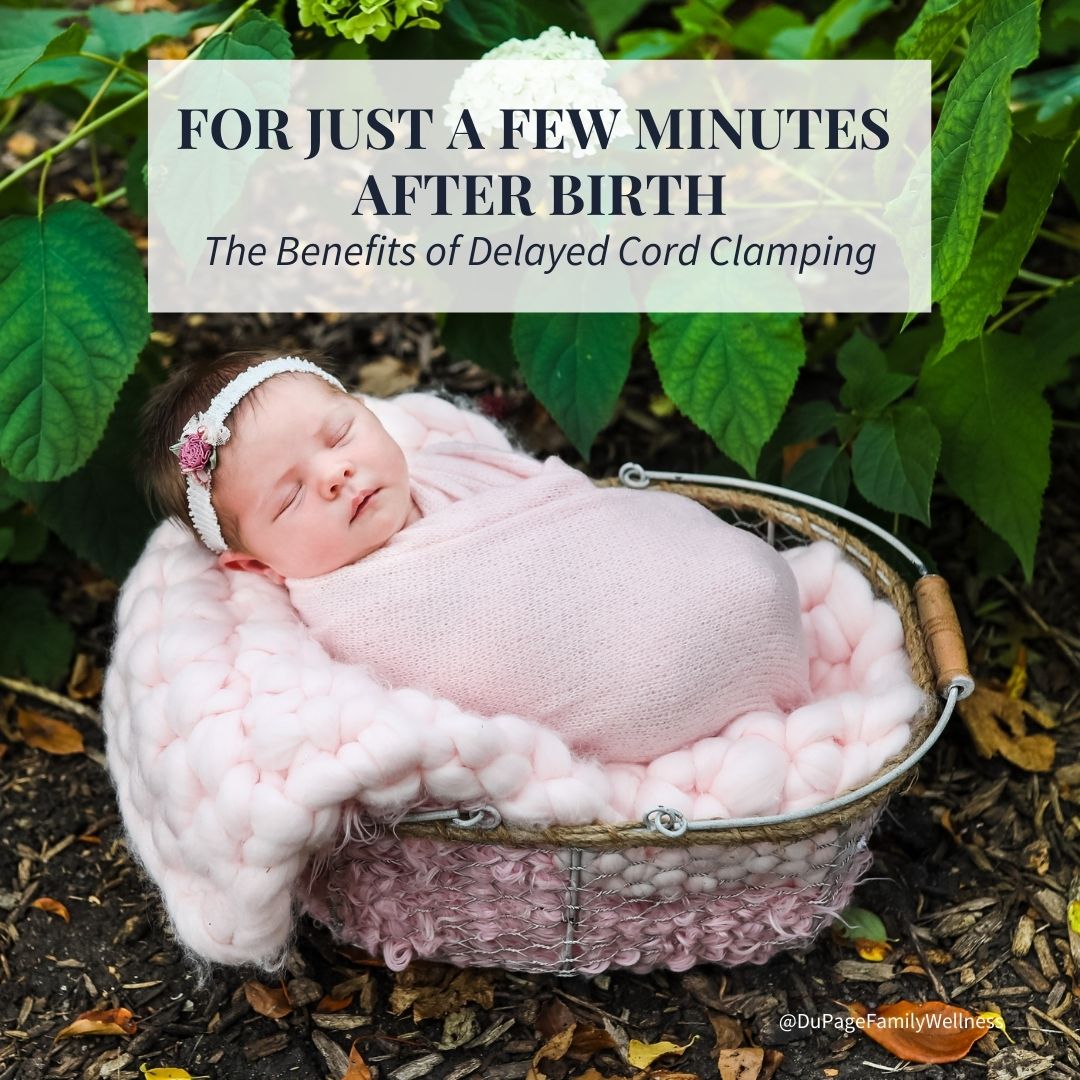 The moments after birth are amazing. You finally get to meet the precious little life that your body has brought into the world. In spite of the exhaustion from the intensity of labor and delivery, holding your baby in your arms for the first time makes it all worth it!
The moments after birth are amazing. You finally get to meet the precious little life that your body has brought into the world. In spite of the exhaustion from the intensity of labor and delivery, holding your baby in your arms for the first time makes it all worth it!
Ideally, these moments will provide mom and baby time together to bond. This may include skin to skin contact and the beginning of the nursing relationship. It is an exciting time for dad and other loved ones as well, as they can now become more involved with the baby’s care.
As the baby adjusts to the world outside of the womb, it is important to honor this transition. One way we can honor the transition is through delayed cord clamping, which allows the baby to receive all the benefits available from the umbilical cord and placenta.
The Umbilical Cord & Placenta
Many people give little thought to the incredible jobs of the umbilical cord and placenta, but they are such crucial roles in the well being of the baby. They work together to provide functions that the baby is not yet able to do one their own.
The umbilical cord is the direct connection between mom and baby, throughout the pregnancy. A vein in the umbilical cord brings nutrient-rich oxygenated blood from the placenta to the baby, while two arteries take carbon dioxide and other waste from the baby to be purified in the placenta.
Cutting the Cord
Since the early 1960’s, it has been standard for doctors to cut the cord seconds after birth.
This is done by clamping the cord in two places and cutting it in between. A small part of the cord remains attached to the baby’s belly button until it dries up and falls off a couple weeks after the birth.
It was thought that early clamping would prevent postpartum hemorrhaging in the mother. This belief has since been disproved, but this practice has remained common even today despite evidence that delayed cord clamping may be really beneficial to the baby.
Read more ...
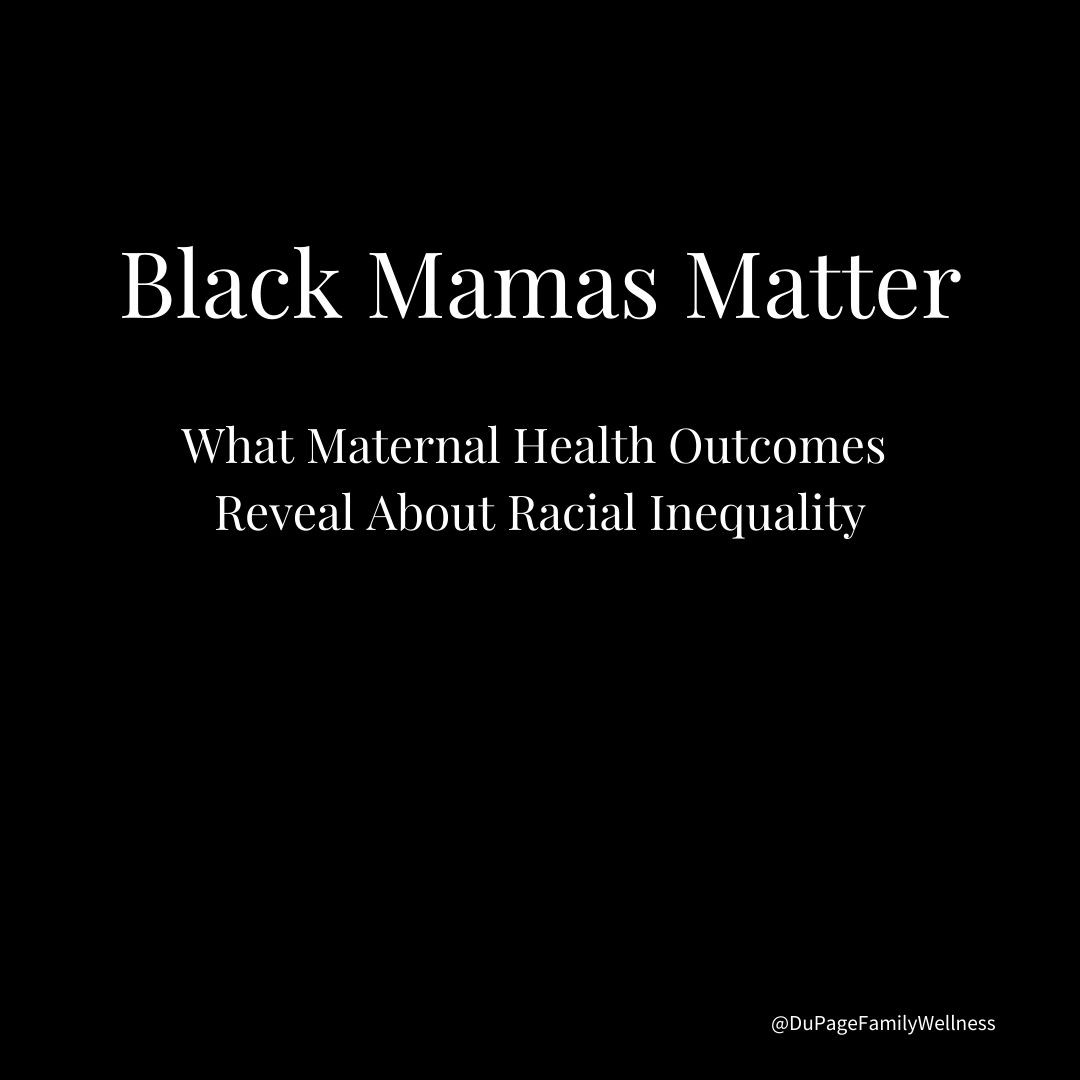 Looking at issues of racial inequality can be uncomfortable. Many people would like to believe that the world treats everyone in a fair manner. When evidence reveals that it doesn’t, we should be uncomfortable, because we shouldn’t be comfortable with injustice.
Looking at issues of racial inequality can be uncomfortable. Many people would like to believe that the world treats everyone in a fair manner. When evidence reveals that it doesn’t, we should be uncomfortable, because we shouldn’t be comfortable with injustice.
One would hope that the medical community - those there to care for your health - would be free from this inequality. Unfortunately, especially when it comes to maternal health outcomes that is simply not the case!
I understand that many things in this article may be hard to read. But if we want to truly understand these issues and make a difference, it is important to take an honest look at both where we are at as a nation and how we got there.
In a way, I hope this article makes you uncomfortable... uncomfortable enough to respond with compassionate action! (And don’t worry, we won’t be focusing only on the problem, there will be some action points at the end of the article so that you can be part of the solution today.)
Even though it is a good thing for many of us to be in this uncomfortable discussion, I want to honor those who have been affected directly by these issues. Therefore I am issuing my first ever trigger warning.
**Trigger Warning - Racial inequality, negative maternal health outcomes, maternal mortality, medical cruelty, etc.**
The Current Truth
In the US, Black women are actually three to four times more likely than White women to die from pregnancy related complications (1). Their babies have twice the rate of preterm deliveries and low birth rates (2). It is important to note that research has found “this increased risk of pregnancy-related death among Black women is independent of age, parity, or education” (3).
One study calculated the amount of patients with preeclampsia, eclampsia, abruptio placentae, placenta previa, and postpartum hemorrhage. It found that while the prevalence rates were the same, Black women were 2 to 3 times more likely to die from these issues then White women were (3).
In order to understand this tragedy, it is important to look at both our history as well as current factors.
Read more ...
 Pregnancy is an exciting time, but it can also be extremely stressful. Your body is changing, and your lifestyle and relationships are about to go through a major transition. If we are honest, at times it can tap into some deep fears and insecurities.
Pregnancy is an exciting time, but it can also be extremely stressful. Your body is changing, and your lifestyle and relationships are about to go through a major transition. If we are honest, at times it can tap into some deep fears and insecurities.
But what if there was a way to prepare your body for birth? A technique developed specifically for the pregnant mom to prepare her for a safer and easier birth.
That’s just what the Webster Technique was created to be!
What is the Webster Technique?
The Webster technique is a specific assessment and chiropractic adjustment developed for use with expectant moms throughout their pregnancy. It was designed to balance the structures in the pelvis and sacrum, in preparation for a safer and easier birth!
How was it Developed
This technique was created by Dr. Larry Webster after he attended the birth of his granddaughter. Although he had used adjustments during the long difficult birth, he felt that a more specific approach of addressing subluxations throughout pregnancy would lead to easier births for both mom and baby.
This led him to develop this very specific assessment and adjustment. This technique focuses on the alignment of the pelvis, as well as relieving the tightness in the ligaments that support the uterus. The Webster Technique prepares your body for the birth of your baby.
The Webster Technique for Preconception (and General Health)
The Webster Technique restores proper alignment and nervous system function to the pelvis, making it appropriate for use in many different types of patients. In fact, you don’t even have to be pregnant to benefit from this technique.
Since the nervous system sends messages from the brain to the rest of the body, having clear communication pathways are essential for optimal functioning. This is important for everyone, but especially those who wish to conceive. This can affect the woman's cycle and restore healthy uterine function, which may positively impact conception outcomes.
The Webster Technique can be applied all throughout the preconception and prenatal experience. Greater alignment is always a good thing!
My Story
During my first pregnancy, knew that the Webster technique was useful towards the end of pregnancy if the baby was not in an ideal position (such as breach). But even as a chiropractor I didn’t realize how beneficial this technique would be throughout my entire pregnancy.
Since I wasn’t in pain, I did not seek out chiropractic care. I didn’t realize that pain is not a good measure of health, because by the time you feel symptoms you likely have already lost 50-60% of function.
I won’t share the details of my difficult birth here other than to say, I ended up having a 43-hour labor that ended with an epidural and the use of forceps.
During my second pregnancy, I was convinced that there was a better way. This time I prioritized being evaluated and adjusted by a chiropractor. I had the Webster technique done throughout my entire pregnancy. Let’s just say that my second delivery was a much different experience!
This time, my body was in alignment and the baby was in an ideal position. In fact, after a much faster, more manageable labor at home, my baby was born in the car on the way to the hospital! (For more of that story read here.)
During my third pregnancy, I came to believe meditation, regular chiropractic adjustments, and the Webster technique were all valuable for an easier delivery. Rather than have another baby in the car, I planned for a home birth. (Read more about my homebirth experience here.)
Facebook Live Video
If you would like more information about the Webster Technique, here is the Facebook Live video.

Knowledge is power when it comes to optimal health, especially through the preconception, prenatal, and postpartum stages. Chiropractic care is a key component in care for every mom. Even without symptoms, so much is changing in a woman’s body throughout pregnancy so extra support is important! The Webster Technique can support you in having your ideal birth, whatever that means for you!
Also, if someone you know is pregnant or trying to conceive, please empower them by sharing this message. Even if they don’t live close to our office in Warrenville, they can search for a local Webster Certified Chiropractor on this website!
Dr. Jamie
It has been found that about 50-70% of women experience back pain at some point during their pregnancy. It is easy to see understand how this would happen since the average weight gain is 25-35 pounds. As the woman’s center of gravity moves forward, the curve in her low back increases. This, in addition to hormonal changes, can cause severe back pain.
Many women have no idea what to do in this situation because they don’t want to take medicine that can be harmful to the baby. Here are some basic exercises and strategies that are not only helpful for reducing pain, but are great for preparing the body for delivery.
Specific Exercises
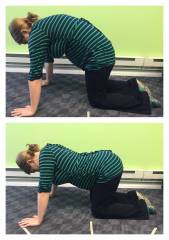 Cat/Camel exercise
Cat/Camel exercise
- Cat/Camel- Start on your hands and knees, and move back up to a flexed position, and then down to an extended position. Alternate between these positions (within a comfortable range) ten times. Do this several times throughout the day. Not only with this help with back mobility and core stability, but it helps the uterus to move up and off the pelvic floor slightly.This is especially beneficial before bed because it can remove some pressure off of your bladder, and allow you to not have to get up quite as frequently throughout the night to urinate. Not Pregnant? This is still a great exercise for anyone experiencing back pain!
- Squatting- Spending some time in a deep squat position daily is great to work hip mobility, and opening up the pelvis in preparation for delivery. Try to get your heels on the ground. Your spine should be in a neutral position and not flexed forward, so it should not bother your lower back in any way. Try to work your way up to at least 30 seconds to a minute of holding this position daily.
 Dr. Thomure squatting at 39 weeks pregnant
Dr. Thomure squatting at 39 weeks pregnant
- Sitting Cross Legged- This is a healthy and natural position for the lower back. It also allows the uterus to move forward increasing circulation and stretching the inner thighs.
What else can I do?
- Get regular low impact exercise such as walking or swimming at least 3 times a week. Try for at least 30 minutes.
- Avoid high heels, instead wear flat comfortable shoes with good arch support.
- Use a pregnancy or body pillow when sleeping, and try to sleep on left side.
- Wear a support belt under lower abdomen. This can help if pelvis is feeling unstable once ligaments are becoming more lax during later pregnancy.
Chiropractic Care
Chiropractors can offer all natural relief to back pain in this situation. According to the American Pregnancy Association, seeing a chiropractor during pregnancy can help with
- Maintaining a healthier pregnancy
- Controlling symptoms of nausea
- Reducing the time of labor and delivery
- Relieving back, neck or joint pain
- Prevent a potential cesarean delivery
How often should I see a chiropractor during pregnancy?
Obviously every patient is different, but Dr. Thomure typically recommends coming about as often as a woman sees her OB. This would mean approximately once a month during the first trimester, 1-2x/month during the second trimester, and 2-4x/month during the third trimester.
Article By Jamie Thomure DC
While this is an article for those of us who are or are thinking about becoming pregnant, it is also important for EVERYONE to read! Most people suffer from some sort of skin condition over the course of their life. This could be anything from acne, to dry skin, to rashes, to psoriasis.
If you watch the news or commercials, you probably think that the only way to combat these problems is with the latest and greatest cream, lotion, steroid, antibiotic, or miracle product. This could not be further from the truth!!! Our skin is a reflection of what is going on under the surface in our bodies.
If we have been eating an inflammatory diet (processed foods, refined sugars etc), this will likely lead to skin reactions! Remember, these inflammatory foods include many items often touted as “Healthy” such as skim milk, low fat yogurt, granola bars, and pretzels. Food is the only fuel that our cells have- and the skin is made of layers of cells! If we aren’t nourishing our bodies with good food, our skin cells are going to reflect that! As they say- you are what you eat! If you need a reminder of what these “good foods” are- check out the first article in the series here!
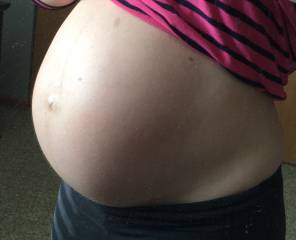 Growing Belly- Still stretch mark free at 38 weeks!
Growing Belly- Still stretch mark free at 38 weeks!
My Top Rule of Skin Care- If I wouldn’t put it in my mouth, I won’t put it on my skin! Just like when I am in the grocery store, I READ THE LABELS. If a product is made of all sorts of processed chemical ingredients that I can’t pronounce or wouldn’t eat, why would I want to absorb them through my approximately 35 billion skin cells!
One of my favorite quote’s about skin care come from the book “Skintervention” by Liz Wolfe NTP. “Beauty starts from the inside and good nutrition is absolutely critical to healthy skin. Anyone who tells you differently, or claims you can beautify or heal your skin or body without good nutrition is absolutely wrong- and probably trying to sell you a product line.”
Stretch marks-
Stretch marks occur when the body is growing faster than the skin can keep up with. Clearly this is happening with a rapidly expanding belly during pregnancy, but is there anything you can do about it? Many studies have shown that belly creams, salves, and balms do not cause a reduction in stretch marks! While many sources say that it is all about having good genes and good luck, I truly believe there are things that you can do to improve the elasticity of your skin. These involve giving it the proper nutrients that it needs to repair and stretch quickly.
Which foods in particular would do this? Foods that are high in collagen (bone broth!), foods high in vitamins A, C, and E, and having a balanced omega 3 to 6 ratio! So what should you be eating? Homemade soups! Gelatin! Nutrient dense good sources of proteins, fats (especially fish for the omega 3s), and lots of multi colored vegetables! Remember, just because you are taking a prenatal vitamin, doesn’t mean that you are off the hook in terms of getting your body and your baby good dense sources of nutritious wholesome food. You can’t supplement yourself out of a bad diet! Staying hydrated throughout pregnancy is also important.
Dry Brushing-
Another thing that you can do to help prevent stretch marks is Dry Brushing. Basically all you do is take a brush made of natural fibers such as this, and brush your dry skin before showering from your fingers and toes toward your heart. This stimulates the lymphatic system to promote drainage, and to help with detoxification. Here is a video that shows how to do it and explains it in a little bit more detail! As an added bonus, doing this also helps to reduce cellulite!
Dry skin-
My advice here is going to be very similar to my advice for avoiding stretch marks. Dry skin during pregnancy can be caused by dehydration, or because nutrients that you normally get are going to the baby. Eating a healthy diet is so important during pregnancy especially because your body is going to prioritize the baby. They baby will get what it needs to grow and thrive- but if there are gaps in your nutrition, you will be the one that takes the hit for it.
Specifically, if you are suffering from dry skin, make sure you are eating enough fat! According to this article, when the skin feels dry, it often means that there is an imbalance or deficiency of fats (and often too high an intake of carbohydrates). Now this isn’t just any old fats we are talking about. Make sure they are the good sources from animals and plants- think coconut, avocado, fish, butter, etc. (and not trans-fats or highly processed fats make in a factory).
Acne-
There are several causes of acne. It is an inflammatory condition, so putting all of the “good things” into your body, and avoiding the processed junk to reduce inflammation is once again crucial.
Most people associate acne with the teenage years when our bodies are going through significant hormonal changes. Unfortunately, pregnancy is another one of those times in life where our hormones are often shifting quite a bit, and for some people, this can mean increased acne or skin breakouts. For others, they actually notice their skin clearing up.
Your hormone levels fluctuate quite a bit during pregnancy, and for some people it seems like some amount of skin breakouts are inevitable. My advice for you would be to do what you can to keep your inflammation levels in your body down (which can have a HUGE impact), and try not to worry about the hormonal skin changes.
Common Misconceptions about acne
1. I have skin problems because my body isn’t clean-
Blemishes occur because of internal imbalances. Ask anyone who has struggled with acne- I bet they will tell you that washing their face more and more doesn’t help- and could actually make it worse
2. I need to use expensive products to have great skin-
Your skin is a living organ (the largest organ in the body actually). It will is not just a barrier, but it will absorb everything you put on it. If you are putting all sorts of products on it with long names that you can’t pronounce, it will absorb those too! There is an AWESOME book all about this called Skintervention by Liz Wolfe, and in this book she recommends 3 simple and natural products for skin care (along with healthy diet and lifestyle). These are Baking Soda (aluminum free), Apple Cider Vinegar, and Coconut oil. You can read all out how to use these products in the book! When you are thinking about what to put on your skin, the first question I ask, is “would I eat this?” because that is virtually what is happening through the absorption process. If the answer is no, why would you want to slather it on your skin to get absorbed?
3. If I have problem skin, I should never use oil on my skin.
Putting something like natural coconut or olive oil on skin can actually help to balance out the oils on your skin. Remember, your skin is going to take in whatever you rub on in it. It is very good at trying to do a balancing act however, so adding oil to your skin can make it produce less oils on its own.
Give yourself Grace-
I wish I could guarantee that by following our advice, you wouldn’t get any unpleasant symptoms during your pregnancy, but that is simply not always the case. It is important to realize that during pregnancy that there is a lot going on in your body. You can’t always control everything. If you are doing what you can to eat as healthy as you can, get sleep, reduce stress levels, and move your body, give yourself grace and accept that your body might do some funny things that are out of your control. Enjoy the ride, and try not to sweat the small stuff!
Article by Jamie Thomure, DC
 Pregnant moms get all sorts of questions. Is this your first? When are you due? Is it a boy or a girl? These questions are born out of excitement and anticipation, but some of these questions are not as straightforward as you may think.
Pregnant moms get all sorts of questions. Is this your first? When are you due? Is it a boy or a girl? These questions are born out of excitement and anticipation, but some of these questions are not as straightforward as you may think.

 The moments after birth are amazing. You finally get to meet the precious little life that your body has brought into the world. In spite of the exhaustion from the intensity of labor and delivery, holding your baby in your arms for the first time makes it all worth it!
The moments after birth are amazing. You finally get to meet the precious little life that your body has brought into the world. In spite of the exhaustion from the intensity of labor and delivery, holding your baby in your arms for the first time makes it all worth it!  Looking at issues of racial inequality can be uncomfortable. Many people would like to believe that the world treats everyone in a fair manner. When evidence reveals that it doesn’t, we should be uncomfortable, because we shouldn’t be comfortable with injustice.
Looking at issues of racial inequality can be uncomfortable. Many people would like to believe that the world treats everyone in a fair manner. When evidence reveals that it doesn’t, we should be uncomfortable, because we shouldn’t be comfortable with injustice. Pregnancy is an exciting time, but it can also be extremely stressful. Your body is changing, and your lifestyle and relationships are about to go through a major transition. If we are honest, at times it can tap into some deep fears and insecurities.
Pregnancy is an exciting time, but it can also be extremely stressful. Your body is changing, and your lifestyle and relationships are about to go through a major transition. If we are honest, at times it can tap into some deep fears and insecurities.

